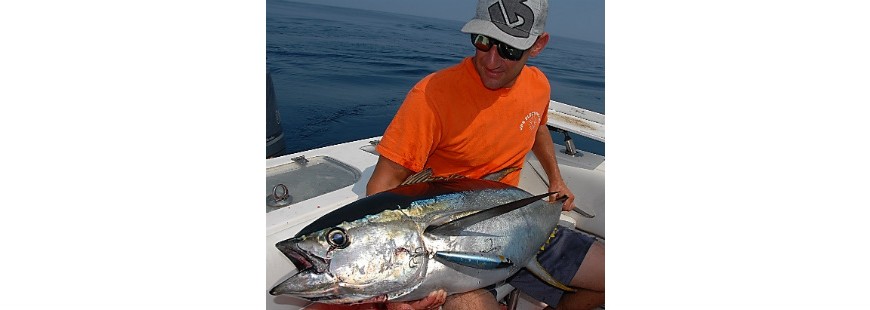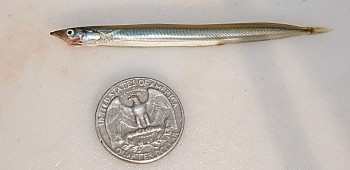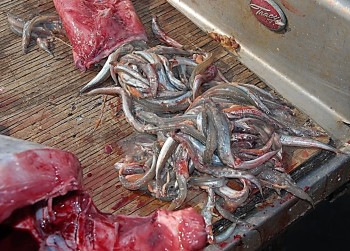I am absolutely hammering yellowfin right now, and well inshore of the canyons (no, I’m not gonna tell you where, LOL). I’m not trolling, or chunking, or doing any of that traditional stuff. I’m catching them on topwater plugs. Yeah, that’s right. These crazy-awesome fish are absolutely smashing topwaters!
It is so freak’n cool I can’t even begin to describe it. Nothing, and I mean nothing, is as intense as a 100-pound missile exploding on a floating stick bait or a popper. It’s insane, man! And the sound that reel makes when they tear off? Sublime…
Why is it so good right now? Pure and simple… Large schools of sandeels have amassed at certain spots. They are so thick at 30 fathoms right now, my sounder sometimes can’t even read bottom.
Of course it isn’t just yellowfin that are attracted to this mass of life, it’s wahoo, white marlin, skipjack, false albacore, mahi, blue runners, whales, turtles, dolphins etc… All kinds of stuff, man. There’s just a crap-ton of life out there right now. All because of these stupid skinny little 4 or 5″ baits. They don’t look like much when ya hold one, but when you put’em all together? Epicness…
So, where am I going with all of this?
There’s some serious concern right now that such “unmanaged” forage fish – those critters which have no oversight in reference to who catches what and how much, such as sandeels – could relatively easily be exploited on a large scale by an industry seeking new forms of income.
Cod, perhaps the most iconic commercial fishery in the Atlantic has crashed, and the groundfish fleet appears to be going down quickly. Mackerel, is pretty much gone. Pretty big constraints could be coming with both menhaden and sea herring as managers consider managing both species as part of the ecosystem. I could go on here… The point is that a lot of fisheries may quickly be getting to the point where there isn’t good money in them anymore. Thus, there’s likely gonna be commercial fishermen looking for new things to exploit. And well, unmanaged forage fish like sandeels are an easy target.
A forage fish species’ tendency to school in large numbers is precisely what makes them so vulnerable. Think about the sandeel concentrations I’m talking about above, and then think about huge small mesh nets scooping them up by the ton. That would really suck, man. If such a thing were to happen, it would probably put me outta business. And no one would get to see the awesomeness of a tuna topwater bite!
Of course it isn’t just sandeels. Imagine if those guys decided to target bay anchovies on a large scale. Forget about my albie season. Or halfbeaks! Anyone who’s ever popped for tuna knows that without these, we’d really miss out. And silversides? And what about chub mackerel?
Think this is an overreaction? Well NOAA has already spent a bunch of taxpayer dollars looking into developing this sort of “underutilized” fishery. Check it out: Development of the Chub Mackerel Fishery as an Underutilized Fishery. Would like to know what all the marlin guys think about that.
Anyway, there’s a lot of vulnerable bait species that really have no oversight right now. Pretty much every “hatch” we depend on could indeed end up as fish-meal or fish-oil or some crap like that.
Yeah, yeah, yeah… I’ve written about this before. Here: On Forage Fish… Managing the Unmanaged, and here: Freezing the Footprint. But I’m writing now with a renewed sense of urgency. Because there is real acknowledgement now from managers that this could be a problem. And guess what… they are actually moving to correct it!
This last December, at the behest of anglers in the Mid-Atlantic, notably CCA MD, the Mid Atlantic Fishery Management Council passed a motion to “initiate a regulatory action to prohibit the development of new, or expansion of existing, directed fisheries on unmanaged forage species until adequate scientific information is available to promote ecosystem sustainability”. In other words the Council is moving to prohibit fishing on a large scale for unmanaged forage species, unless science exists or can be developed to prove that it is sustainable… Not just sustainable for fishermen, but sustainable for the entire ecosystem. That means making sure there are enough in the water for predators.
This is a very progressive, precautionary move the Council is making. Something it wouldn’t have even considered 5 or 6 years ago. It’s a big, big deal IMO. But there’s a long way to go before this happens, if indeed it does happen.
So where are we now? The Council has initiated a “scoping process” (a fancy way of saying information gathering). The idea is to solicit input from the public before developing options on how to do this. The public. That’s you!
There are a series of public hearings scheduled (listed below) where you can do this. You can of course also send comments via email, fax or snail-mail (again, info below). But the important thing is that you do comment, because this stuff is important for us.
All this said, what the Council probably doesn’t want is a lotta anglers coming up and passionately saying that forage fish like sandeels, bay anchovies etc. are important. The Council clearly already knows this, or they wouldn’t have initiated the action.
What the Council is asking for are comments re how to do this. Specifically on 8 unique questions. I’ve broken them down below, and provide my personal thoughts on each.
Re question #1: What type of action would be most appropriate?
Without getting too much into the weeds, there are three actions the Council is considering: (A) Amending one of the current fishery management plans to include protections for forage; (B) Creating a new plan; or (C) Addressing new fisheries for unmanaged forage species as they arise.
My opinion on this is that it’s all about timing/urgency here. I think we need to get this done sooner rather than later for a few critical reasons, which I won’t go in to detail here. But the short version is that if we don’t get it done now, within the next two years, while we have a good Council and momentum, it’s entirely possible it won’t get done at all.
With that in mind, creating a new plan is likely the most time consuming. Re addressing new fisheries as they develop? That’s akin to doing nothing really. So amending an existing plan seems like the best route in my opinion.
So yeah, option A is probably our best bet.
Re question #2: What type of management provisions would be most effective?
Again there are three “provisions” here. Basically they are considering adding unmanaged forage to a fishery management plan as an “ecosystem component species”, a “stock in the fishery” or as part of “essential fish habitat”.
All ya really need to know here is that provision A – “Identify forage species as ‘ecosystem component’ species and prohibit their directed harvest” – makes the most sense. I’m not gonna get into details why, because it’s way too wonky, but the short version is the “stocks in the fishery” thing just isn’t practical here, and there are too many holes in the “essential fish habitat” stuff. So… Question 2, option A.
Re Question 3: Which forage species should be included in this action?
This one is pretty important. The Council has identified 8 species based on a forage definition developed by authors of a recent white paper. They are as follows:
Sandeel, bay anchovy, striped anchovy, silver anchovy, round herring, thread herring, Spanish sardine, and silverside.
I know what you’re thinking. What about menhaden (bunker), what about river herring (alewives and bluebacks), what about mackerel, what about squid, what about butterfish!? Well, for better or worse, large scale fisheries developed on them an awfully long time ago, and they are currently managed by the Feds or the states. Keep in mind that we are talking about unmanaged forage here.
There are 12 other species currently under consideration (you may find that list in the scoping document). Honestly I haven’t really heard of most of them. But take a look at that list and also consider the 8 species above.
Are there any more you want to see protected/added to the list? Like maybe krill, certain crabs, shrimp, worms? If so the Council needs to hear about them!
Re question #4: What types of fishing should be addressed?
The intent of this action is to prevent new large-scale fisheries from developing in federal waters. My first thought on this is that we’re talking about commercial fisheries. The intent of course is not to shut down any existing small-scale or recreational fishery.
That said… I could see new recreational bait fisheries developing on something like sandeel. Or what about the recreational guys who just want to catch bait (which is kinda unlikely in federal waters – keep in mind this is a federal action not a state one). I don’t consider any of this “large scale” or detrimental to the sandeels or predators that rely on them, but frankly I don’t know.
Plus there is the whole problem of defining “large scale”. That could be problematic.
I think the answer to all of this is to recommend addressing all fisheries (whether they are commercial, recreational or whatever) IF they could possibly have a significant impact on forage populations. That would cover all the bases.
Re question #5: What is the most appropriate geographic scope of the action?
This is a tricky one I think. Yes, this action should apply to as great an area as possible to provide the most comprehensive protection for forage species and ecosystems. But… there are caveats. The broader the range, the more difficult this would be to get done.
For instance, if we were to extend the range up to New England waters we’d have to coordinate with the New England Council. One needn’t look any farther than groundfish to see how they’ve managed things. And if we were to extend it to state waters, well, if you’re a regular reader of my blog, you know that’s probably a really bad idea. The Atlantic States Marine Fisheries Commission (ASMFC) isn’t exactly the most conservation-minded, progressive body. I’m pretty sure that if we did this, the entire process would get really jammed up.
The Mid-Atlantic Council should probably focus on its jurisdiction first, and then encourage neighboring management bodies follow suit.
Re question #6: What are the most effective ways to prohibit the expansion of existing fisheries?
Yes, it’s important that with this action we prevent the expansion of those unmanaged forage fisheries that currently exist. The problem is, we don’t really have a good grip on what actually does exist out there.
I don’t think this is as big of an issue as some are making it out to be. If such fisheries were significant, we’d know about them. If they begin to become significant, we’d find out about them pretty quickly I’m sure.
I think that just by way of this action, we’ll prevent any real, large-scale fishery from developing through expansion of an existing one. Like I said, they can’t expand significantly and still operate under the radar. And the action will be pretty clear that ecosystem sustainability science is required for a fishery on forage that is, well, significant enough for the Council to take notice.
But yes, there is still some work (analysis and development) for the Council to do here. Primarily finding out what actually does exist in federal waters. I don’t think it’s significant, but hey, I could be wrong.
Re question #7: What is an appropriate process for allowing new fisheries to develop?
Once again, the intent of this action isn’t to prohibit new fisheries for unmanaged forage indefinitely, but only until enough scientific information is available to “promote ecosystem sustainability”.
So how do we allow such new fisheries to safely develop?
The Council should probably follow the same path that the Pacific Council did with their unmanaged forage action. They decided to allow limited “exempted fishing permits” (read: controlled experimental fisheries) as a way of encouraging data collection and developing the science. Basically a preliminary precautious step towards developing new fishery.
There’s one more question.
“What scientific data and models are available to inform the action?”
Don’t think we need to worry too much about this one. It was kinda slipped into the scoping document at the last minute by an industry rep. I’m so jaded I can’t help but think it’s meant to steer the Council away from anything that we don’t have rock solid science for. Which is probably unwarranted as really, the intent here is to try and protect the stuff we don’t have a lot of information on, at least until we do have more info. At any rate, there’s no harm in looking into the science/data/models that could possibly be of use.
That’s it for the questions… But lastly, I want to point out that there’s concern from industry about how we handle unmanaged forage bycatch. I do understand the concern regarding possible “choke species”, but there’s plenty of precedent re how the Pacific Council dealt with this (e.g. de minimis status). We’ll certainly hear about that. This is something the Council should address moving forward, so we have full buy-in.
But let me wrap up here, as this is already too long. The hearing dates/times/places are below as well as info on how to comment via email or fax.
Like I said. This is really darn important, man. Without the bait, we just don’t have the fish. And you can be sure that there will be people trying to get the Council not to do this, or to do something weaker than where the Council is currently heading.
Right now is the first and best opportunity for anglers to make suggestions and raise concerns about unmanaged forage. Comments early in the process (ehm, right now) will help steer the council in the right direction with this.
But please try and focus those comments specific to the 8 questions asked.
The above are my thoughts on the Council’s Unmanaged Forage Scoping document. Plagiarize/use them as you see fit.
Out…
HOW TO SUBMIT COMMENTS:
[Details]
Written comments must be received by 11:59 pm Eastern Standard Time on Friday October 2, 2015.
Written comments may be sent by any of the following methods:
1) Online at www.mafmc.org/comments/unmanaged-forage
2) Email to the following address: jbeaty@mafmc.org
3) Mail or Fax to:
Dr. Chris Moore, Executive Director
Mid-Atlantic Fishery Management Council
800 North State Street, Suite 201
Dover, DE 19901
FAX: 302-674-5399
Please include “Unmanaged Forage Scoping Comments” in the subject line if using email or fax or on the outside of the envelope if submitting written comments.
PUBLIC HEARINGS:
North Carolina:
Sept. 15, 2015 6:30- 8:30 pm NC DMF Washington Regional Office Hearing Room 943 Washington Street, Washington, NC, 27889 252-946-6481
Virginia:
Sept. 16, 2015 6:00- 8:00 pm Virginia Marine Resources Commission 4th Floor Meeting Room 2600 Washington Avenue, Newport News, VA, 23607 757-247-2200
Maryland:
Sept. 30, 2015 6:30- 8:30 pm Worcester County Library Ocean Pines Branch 11107 Cathell Rd, Berlin, MD, 21811 410-208-4014 Oct. 1, 2015 6:30- 8:30 pm
New Jersey:
Sept. 17, 2015 6:30- 8:30 pm Congress Hall Hotel 200 Congress Place, Cape May, NJ, 08204 844-264-5030
New York:
Sept. 21, 2015 6:30- 8:30 pm Kingsborough Community College, Building T-3 2001 Oriental Boulevard, Brooklyn, NY, 11235 718-368-5000
Sept. 29, 2015 6:30- 8:31 pm NY DEC Bureau of Marine Resources Hearing Room 205 North Belle Mead Road, Suite 1, East Setauket, NY, 11733 631-444-0430
Rhode Island:
Sept. 28, 2015 6:30- 8:30 pm University of Rhode Island Bay Campus Corless Auditorium 215 South Ferry Rd, Narragansett, RI, 02882 401-874-6222






Dear Sir Madam,
In the past 3 to 4 years we start seeing a good comeback for Yellowfin tuna and bluefin tuna to our water in New York/ New Jersey.
All that was accounted to the amount of Sand eels that start to comeback to our water, giving a permit to harvest the Sand eels will result for the disappearing of this fishery that we all enjoyed in the past couple of years, I am sure many had profited from that including Hotel, Tackle shop, Marina, Gas station not to mention the smiles that brought to our Noreast anglers.
As a result I ask you not to give permit allowing to harvest the Sand Eels!
Tight lines
Sami
Saltywater Tackle Inc
Pingback: Of Sandeels and Tuna: We Need Your Help Getting Ahead of the Curve – John McMurray | Talking Fish
I attended the public hearing last night and was very pleased to hear the comments from concerned recreational fishermen. They offered their insights into the condition of the nearshore waters, habitat and the forage animals found there.
In their opinion and according to their observations the abundance, range and habits of many of these forage species were in decline. It was troubling to hear that they feel the degradation nearshore is a serious problem and likely the cause of these recent trends.
Commercial fishermen are seeing many changes offshore beyond states waters but are encouraged by the abundance of forage fish.
I also must add that the recreational fishermen who attended were very sincere and provided comments without any negative comments towards the commercial fishing industry.
We appreciate the mutual respect and hope for the best.
Greg DiDomenico
Garden State Seafood Association
Pingback: Help Protect The Forage Fish
Pingback: Comments Needed for Unmanaged Fisheries! A Rare Opportunity! | Brooklyn Urban Anglers Association
Pingback: Holy Mackerel! | Marine Fish Conservation Network